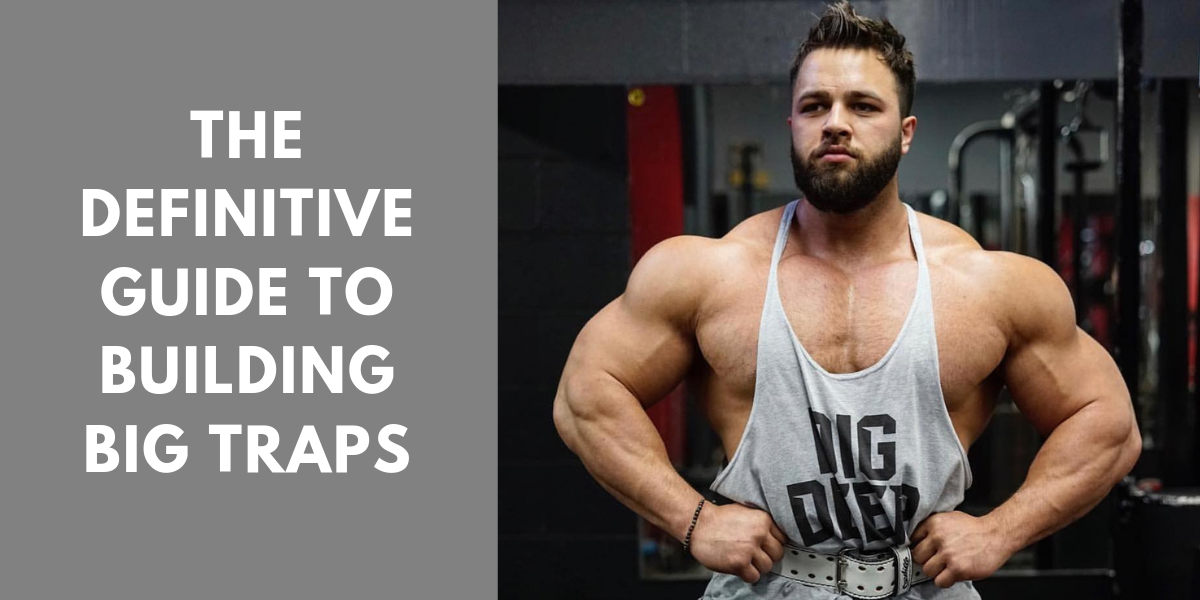If you want to know how to get bigger traps, the kind that makes you look “yoked”, then you'll want to read this article.
Nothing says strength and power like a monster set of large traps.
Yet, many hard-working gym rats fail to achieve an impressive set of large traps. You could almost say they’re trap “deficient”.
If you want complete trap development, the kind that would even make the Incredible Hulk blush, then you’re going to need to do more than just heavy deadlifts and the occasional sloppy sets of shrugs at the end of your shoulder workouts.
For monster traps, you need specific, targeted exercises and training techniques that thoroughly beat them down. Remember, the traps are an incredibly strong group of muscles. They can take a lot of abuse.
The good news is that you are already performing many of the best exercises for bigger traps. You just need to start performing more of them and training them with greater intensity.
Ahead, we’ve got a complete guide to help you learn how to build big traps.
Fuel Your Workouts
Let’s start by reviewing some basic human anatomy.
Trap Anatomy 101
By understanding the form, function, and fiber composition of the traps, you’ll be able to more effectively train them to grow bigger and stronger.
As you probably could have guessed, the traps get their name trapezius due to their striking trapezoid-like shake. The traps are broad and flat, lying just beneath the skin. They extend longitudinally from the occipital bone on the back of the skull to the lower thoracic vertebrae of the spine and laterally to the spine of the scapula.
The traps are comprised of three distinct regions:
-
Upper
-
Middle
-
Lower
The main function of the traps is to stabilize and move the scapula.
The upper traps elevate the scapula, the mid traps retract the scapula, and the lower traps depress the scapula. In addition to translation, the muscle fibers of the traps also help rotate the scapula.
Since the traps are involved in so many different actions, to work the different regions of the traps, we will need to use a variety of exercises and angles to effectively stimulate all aspects of the traps.
Exercises involving elevation of the shoulder (such as the hang clean) help develop the upper traps, while exercises involved with pulling the shoulder blades together (such as a row or face pull) can help develop the fibers of the mid trap.
The lower traps are often very underdeveloped in most lifters, for no other reason than that most lifters fail to properly train them. Exercises where the shoulder blades are drawn down while keeping the arms straight (like prone Y raises) help strengthen this oft-neglected muscle group.
Generally, the traps are pretty evenly split in muscle fiber composition between slow and fast-twitch muscle fibers, with slow-twitch fibers accounting for 55% of fiber types while fast-twitch make up the remaining 45%.
Why is this important?
Since the traps are a good mix of slow and fast-twitch fibers, that means you should use both heavy weights and low reps as well as lighter weights and higher reps to train them thoroughly.
In other words, some time should be spent in the 6-12 rep range, and some of your training sets should be in the 15-30 rep range.

The Best Exercises for Big Traps
Deadlifts
The deadlift isn’t only an amazing trap builder, it’s also a great everything builder.
The traps can take a lot of punishment, and deadlifts allow us to subject our traps to incredibly heavy loads for a considerable amount of time. By adding a subtle “tweak” to the conventional deadlift, we can also get more trap-building bang for our exercise buck.
After each rep of the deadlift, before lowering the bar, perform 3 shrugs. After the third shrug is complete, then you will lower the bar to the ground.
This unique deadlift-shrug combo trains both the contractile and isometric strength of the traps, and helps increase overall time under tension for the traps, which helps spur muscle growth.
Rack Pulls
Rack pulls are deadlifts with training wheels. Instead of starting with the bar on the ground, rack pulls start with the bar usually around mid-shin to knee height off the floor held in place by safeties.
Since you’re getting some help on the initial part of the lift, you’ll be able to use a heavier load than your regular deadlift weight. This can help a provide greater overload for the traps; however, since the overall range of motion is less you must milk each rep for all its worth to maximize time under tension.
Hang Clean and Press
The hang clean and press is another staple exercise for building bigger, beefier traps. It was a favorite of Arnold’s and if it’s good enough for the Governator, it’s good enough for you. Not only that, but in addition to taxing the traps, this exercise also blasts just about every other muscle in your body, making it a true total body mass builder.
As a bonus, the hang clean and press can be done with greater frequency than the deadlift and can be performed with just about any free weight you have lying around the gym -- dumbbells, barbells, kettlebells, or sandbags.
Loaded Carries
Loaded carries (a.k.a. Farmer’s walks) are about as simple as it gets when it comes to exercise. Pick up a heavy weight, hold it at your side, and then start walking.
There's a reason the World's Strongest Men all have monster traps -- they do a lot of loaded carries and farmer’s walks.
Farmer's walks build massive traps, a thick neck, and huge forearms. They’re also a phenomenal exercise for increasing grip strength as well as the muscles protecting your spine.
If you’re new to farmer’s walks, start by holding a pair of heavy dumbbells at your sides. Make sure when you start walking that you keep an upright, tall posture with shoulders pulled down and back -- no hunching over here!
You can experiment with longer walks using lighter loads, or “sprints” involving very heavy loads over short distances.
Shrugs
Shrugs are a staple trap-building exercise, yet despite lifters hammering their traps with lots of reps with heavy weight, they still get little growth.
That’s because they’re not performing the exercise properly.
You see, shrugs as an exercise have very limited range of motion. So, when you’re doing a bunch of jerky, up and down reps your muscles are receiving very little time under tension.
What you should be doing when performing any type of shrug is holding at the top for 3-5 seconds.
Now, this inevitably means you’ll have to lighten the load you’re using, and temper your fragile ego, but the gains you’ll reap from the improved technique will yield better growth in your traps.
While you could use a barbell for shrugs, we’re partial to the dumbbell variety, using the 3-5 second squeeze at the top.
Make sure that you are not jerking the weights up and down when performing shrugs. Remember, you’re trying to use the traps to do the work, not momentum and body English. All that flailing and jerking puts undue stress on the neck and sets you on the road to eventual injury.
Also, make sure that when you are performing shrugs you do NOT stick your head out in front of your body. This can lead to pain in the neck and possible nerve damage. Make sure you are looking straight ahead when performing shrugs, do not look up, down, or to either side.

The Best Workout for Bigger, Stronger Traps
You know how to get bigger traps, and training them one time per week at the end of a shoulder or back workout isn’t going to cut it. To make the traps grow, you’re going to have to force them to grow by increasing training frequency and volume.
In layman’s terms, that means training the traps separately on two separate days during the week.
Trap Workout 1
|
Exercise |
Sets |
Reps |
Rest |
||
|
Deadlift-Shrug Combo* |
3 |
5 |
2-3 min |
||
|
Power Clean |
5 |
3 |
2-3 min |
||
|
Overhead Plate Raise |
4 |
10 |
60-90 sec |
||
|
Cable (Banded) Face Pulls |
4 |
12-15 |
60 sec |
*Note: Make sure at the top of every rep of the deadlift you are performing 3 shrugs before returning the bar to the floor.
Trap Workout 2
|
Exercise |
Sets |
Reps |
Rest |
||
|
Rack Pull |
3 |
5 |
2-3 min |
||
|
Hang Clean & Press |
5 |
3 |
2-3 min |
||
|
Dumbbell Shrugs |
4 |
10 |
60-90 sec |
||
|
Farmer’s Walk |
2 |
** |
120 sec |
**For each set of Farmer’s Walk, walk 30 feet down and back 3 times
Fuel Your Workouts with Intracell 7
Intracell 7 is premium-grade training fuel for your high-intensity trap training sessions. Each serving of Intracell 7 supplies fast-digesting carbohydrates along with essential amino acids, electrolytes, and blood flow enhancers to support athletic performance and reduce fatigue.
Intracell 7 also tastes delicious and won’t leave you feeling heavy or sluggish during your training sessions.
Have a scoop pre-workout and sip on another serving during your workout for added hydration, energy, and performance.









Leave a comment
This site is protected by hCaptcha and the hCaptcha Privacy Policy and Terms of Service apply.